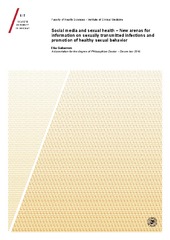Sexual and Reproductive Health among University Students in Addis Ababa, Ethiopia. The influence of gender and sexuality on sexual and reproductive health.
Permanent link
https://hdl.handle.net/10037/15188Date
2018-10-09Type
Master thesisMastergradsoppgave
Author
Rolandsen, SusanneAbstract
The project focuses on sexual and reproductive health among university students in Addis Ababa Ethiopia. The intention is to investigate how gender and sexuality influence student’s sexual and reproductive health. Moreover, the aim is to investigate how youth perceive their knowledge about sexuality and sexual and reproductive health, how they understand the responsibility of women and men in sexuality and sexual and reproductive health and how understandings about sexuality, gender relations and reproduction affect their sexual behaviour. It also investigates how youth’s understandings can be utilized in order to raise awareness and use of sexual and reproductive health services, and to increase the relevance of the information provided.
The study has been conducted at Addis Ababa University, through qualitative methods. 15 in-depth interviews with students, three focus group discussions with students, and five interviews with employees/volunteers at SRH services on campus has been conducted. In total, 35 people have been interviewed. A document analysis of the three strategies National Adolescent and Youth Reproductive Health Strategy 2007-2015, National Adolescent and Youth Health Strategy 2016-2020 and Communication Strategy on HIV/AIDS and Sexual Reproductive Health for Higher Education Institutions has also been conducted. The aim is to make visible (potential) differences at the political/legal level and among laypeople.
The findings indicate that (perceptions of) gender and sexuality strongly influence people’s sexual practices and sexual and reproductive health. It also influences people’s knowledge about the topics and their abilities to engage in safe sex. There also seems to be a gap between the political/legal level and laypeople’s perceptions – both of the problem and what the solutions would be.
Publisher
UiT Norges arktiske universitetUiT The Arctic University of Norway
Metadata
Show full item recordCollections
Copyright 2018 The Author(s)
The following license file are associated with this item:
Except where otherwise noted, this item's license is described as Attribution-NonCommercial-ShareAlike 3.0 Unported (CC BY-NC-SA 3.0)
Related items
Showing items related by title, author, creator and subject.
-
Social media and sexual health – New arenas for information on sexually transmitted infections and promotion of healthy sexual behavior
Gabarron, Elia (Doctoral thesis; Doktorgradsavhandling, 2017-05-05)Objectives: The objectives of this thesis are to investigate the use of social media for health promotion dealing with sexually transmitted infections, their value for improving health and increasing the promotion reach, and to provide examples on how social media users retrieve information about sexually- transmitted infections from these media. I want to investigate the nature of the information ... -
Sexual incentive motivation, sexual behavior, and general arousal: Do rats and humans tell the same story?
Ågmo, Anders j; Laan, Ellen (Journal article; Tidsskriftartikkel; Peer reviewed, 2022-02-26)Sexual incentive stimuli activate sexual motivation and heighten the level of general arousal. The sexual motive may induce the individual to approach the incentive, and eventually to initiate sexual acts. Both approach and the ensuing copulatory interaction further enhance general arousal. We present data from rodents and humans in support of these assertions. We then suggest that orgasm is ... -
Sexual Incentive Motivation and Sexual Behavior: The Role of Consent
Ågmo, Anders j; Laan, Ellen (Journal article; Tidsskriftartikkel; Peer reviewed, 2023-09-22)The generalized social concern with sexual harassment and nonconsensual sex makes it imperative to incorporate notions of consent in any analysis of human sexual interactions. Such interactions follow an ordered sequence of events, starting with the perception of a sexual incentive, followed by an approach to it, genital interaction, and eventually orgasm. Consent from the partner is needed at ...


 English
English norsk
norsk



